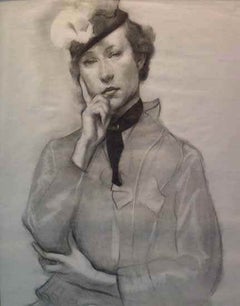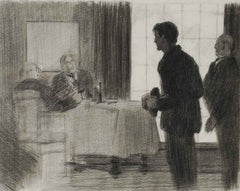Robert McIntosh Figurative Drawings and Watercolors
For more than seven decades, artist Robert McIntosh expressed his joy for life through drawing and painting. His approach to visual art ran the spectrum, from bold, monochromatic landscapes to vibrant renderings that are alive with color, never confining his work to a single style. Whether using surreal abstract scenes to evoke ephemeral thought or realism for portraits, McIntosh brought the canvas to life with masterful skill.
McIntosh was born in 1916 in Vallejo, California, near San Francisco. By the time he was 10, he had a passion for painting. His creative interests intensified when his family moved to Stockton, California, when he was 12, just a few blocks from a local art museum. He visited the museum often, feeding his desire for artistic knowledge.
In 1934, McIntosh received a scholarship to the Pasadena Art Center School of Design. Soon, he was taking commissions to paint portraits. Not long after, notable museums in the state began exhibiting his work, including the San Francisco Museum of Art (now the San Francisco Museum of Modern Art) and the Crocker Art Museum in Sacramento.
During the Great Depression, McIntosh worked at Disney Studios, creating background art for animated films. In 1940, he married fellow Disney artist Helen Nerbovig. The military drafted him in 1942, and he worked for the U.S. Army Air Force at Hal Roach Studios. After the war, McIntosh split his time between freelance work for animation studios, like Warner Bros. and Hanna-Barbera, and work on his art, which was exhibited annually at the Los Angeles County Museum of Art.
McIntosh continued to paint and sketch throughout his career, consistently producing works of diverse media. He experimented with Expressionism, Cubism, Impressionism and collage. He lived and worked in Bel Air, California, until he died in 2010. Through his many decades of creative expression, McIntosh left a body of work that continues to be treasured by collectors today.
On 1stDibs, find Robert McIntosh’s figurative paintings, landscapes and drawings and watercolors.
1930s Art Deco Robert McIntosh Figurative Drawings and Watercolors
Graphite
1930s Robert McIntosh Figurative Drawings and Watercolors
Pastel
1930s Realist Robert McIntosh Figurative Drawings and Watercolors
Watercolor
1930s Art Deco Robert McIntosh Figurative Drawings and Watercolors
Charcoal, Paper
1930s Robert McIntosh Figurative Drawings and Watercolors
Graphite, Paper
16th Century Old Masters Robert McIntosh Figurative Drawings and Watercolors
Ink, Gouache, Pen
Late 20th Century Modern Robert McIntosh Figurative Drawings and Watercolors
Pencil, Paper
18th Century Old Masters Robert McIntosh Figurative Drawings and Watercolors
Handmade Paper, Graphite
2010s Realist Robert McIntosh Figurative Drawings and Watercolors
Paper, Acrylic
Early 1900s Realist Robert McIntosh Figurative Drawings and Watercolors
Board, Watercolor
2010s Contemporary Robert McIntosh Figurative Drawings and Watercolors
Other Medium, Archival Paper, Handmade Paper, Pen, Felt Pen, Permanent M...
1940s Realist Robert McIntosh Figurative Drawings and Watercolors
Gouache, Graphite, Pen, Watercolor
21st Century and Contemporary Modern Robert McIntosh Figurative Drawings and Watercolors
Paper, Charcoal, Graphite
1950s Realist Robert McIntosh Figurative Drawings and Watercolors
Paper, Tempera
Mid-20th Century Modern Robert McIntosh Figurative Drawings and Watercolors
Pencil
21st Century and Contemporary Contemporary Robert McIntosh Figurative Drawings and Watercolors
Paper, Charcoal, Pastel, Acrylic, Wood Panel, Graphite
2010s Realist Robert McIntosh Figurative Drawings and Watercolors
Paper, Acrylic





